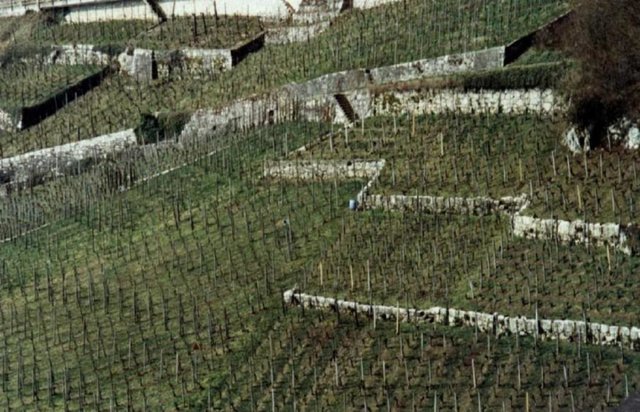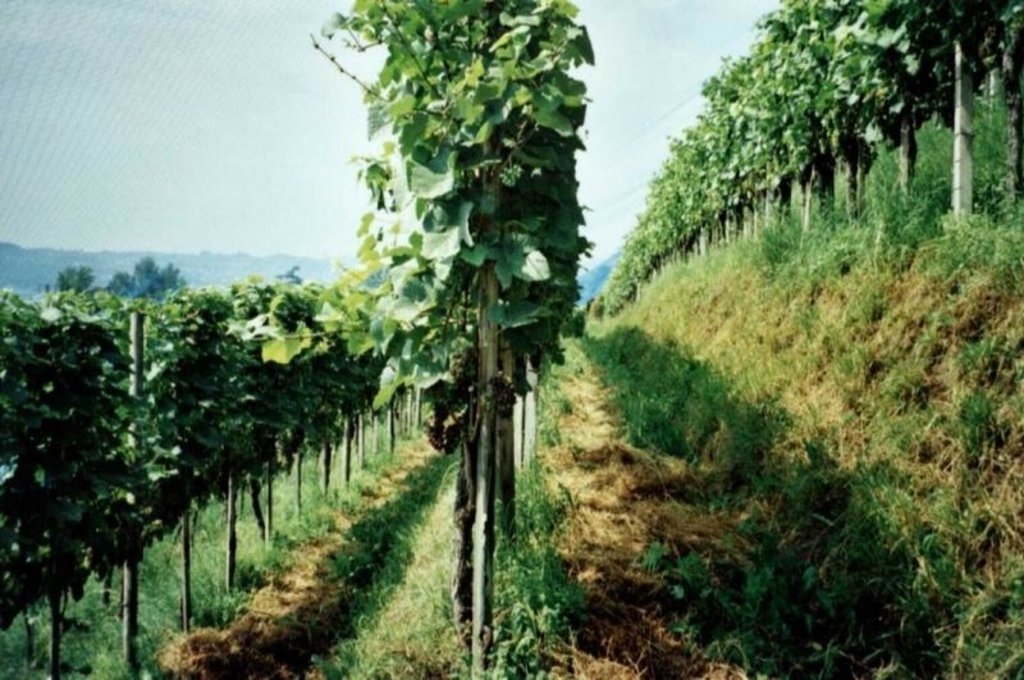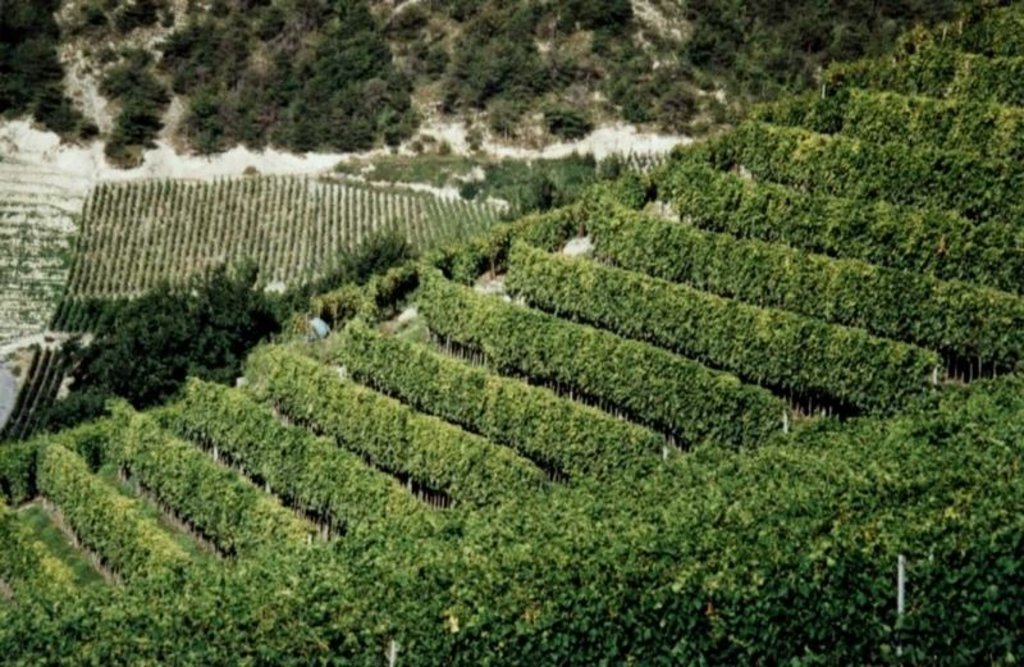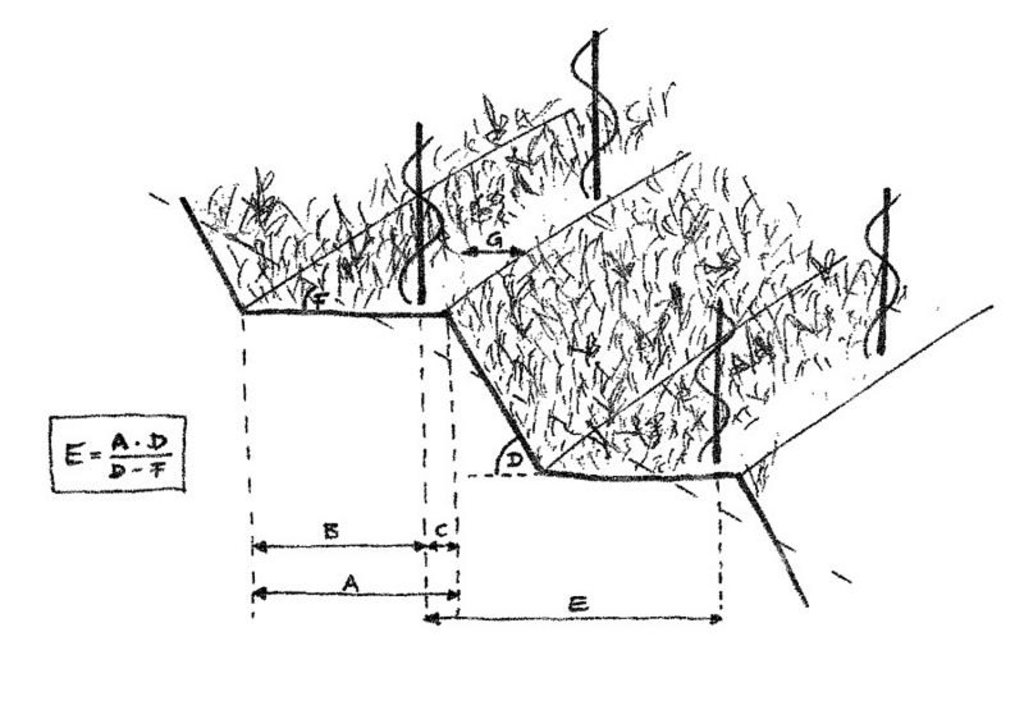Contour small bench terraces with permanent green cover in vineyards [ສະວິດເຊີແລນ]
- ການສ້າງ:
- ປັບປູງ:
- ຜູ້ສັງລວມຂໍ້ມູນ: Nicole Guedel
- ບັນນາທິການ: –
- ຜູ້ທົບທວນຄືນ: Fabian Ottiger, Alexandra Gavilano
Ganzjährig begrünte Kleinterrassen im Rebbau
technologies_1011 - ສະວິດເຊີແລນ
ເບິ່ງພາກສ່ວນ
ຂະຫຍາຍທັງໝົດ ຍຸບທັງໝົດ1. ຂໍ້ມູນທົ່ວໄປ
1.2 ຂໍ້ມູນ ການຕິດຕໍ່ພົວພັນ ຂອງບຸກຄົນທີ່ສໍາຄັນ ແລະ ສະຖາບັນ ທີ່ມີສ່ວນຮ່ວມ ໃນການປະເມີນເອກກະສານ ເຕັກໂນໂລຢີ
ຜຸ້ຊ່ຽວຊານ ດ້ານການຄຸ້ມຄອງ ທີ່ດິນແບບຍືນຍົງ:
Weissenbach Peter
Federal Research Station for fruit-growing, viticulture and horticulture-FAW
ສະວິດເຊີແລນ
ຜຸ້ຊ່ຽວຊານ ດ້ານການຄຸ້ມຄອງ ທີ່ດິນແບບຍືນຍົງ:
Spring Jean-Laurent
Federal Research Station for fruit-growing, viticulture and horticulture-RAC
ສະວິດເຊີແລນ
ຜູ້ນໍາໃຊ້ທີ່ດິນ:
Louis Hannes
Louis Weinbau
ສະວິດເຊີແລນ
ຜູ້ນໍາໃຊ້ທີ່ດິນ:
Hasler Lukas
Hasler Weinbau
ສະວິດເຊີແລນ
ຊື່ສະຖາບັນ (ຫຼາຍສະຖາບັນ) ທີ່ອໍານວຍຄວາມສະດວກ ໃນການສ້າງເອກກະສານ / ປະເມີນ ເຕັກໂນໂລຢີ (ຖ້າກ່ຽວຂ້ອງ)
Federal Research Station for fruit-growing, viticulture and horticulture (FAW/RAC) - ສະວິດເຊີແລນຊື່ສະຖາບັນ (ຫຼາຍສະຖາບັນ) ທີ່ອໍານວຍຄວາມສະດວກ ໃນການສ້າງເອກກະສານ / ປະເມີນ ເຕັກໂນໂລຢີ (ຖ້າກ່ຽວຂ້ອງ)
CDE Centre for Development and Environment (CDE Centre for Development and Environment) - ສະວິດເຊີແລນ1.3 ເງື່ອນໄຂ ກ່ຽວກັບ ການນໍາໃຊ້ຂໍ້ມູນເອກະສານ ທີ່ສ້າງຂື້ນ ໂດຍຜ່ານ ອົງການພາບລວມຂອງໂລກ ທາງດ້ານແນວທາງ ແລະ ເຕັກໂນໂລຢີ ຂອງການອານຸລັກ ທໍາມະຊາດ (WOCAT)
ຜູ້ປ້ອນຂໍ້ມູນ ແລະ ບຸກຄົນສຳຄັນ ທີ່ໃຫ້ຂໍ້ມູນ (ຫຼາຍ) ຍິນຍອມ ຕາມເງື່ອນໄຂ ໃນການນຳໃຊ້ຂໍ້ມູນ ເພື່ອສ້າງເປັນເອກກະສານຂອງ WOCAT:
ແມ່ນ
1.5 ແບບສອບຖາມທີ່ອ້າງອີງເຖີງແນວທາງ ການຄຸ້ມຄອງທີ່ດິນແບບຍືນຍົງ (ໄດ້ເຮັດເປັນເອກະສານທີ່ໃຊ້ WOCAT)

Farmer initiative within enabling environment [ສະວິດເຊີແລນ]
Initiative and innovation of land users, stimulated by government's technical and financial support.
- ຜູ້ສັງລວມຂໍ້ມູນ: Nicole Guedel
2. ການອະທິບາຍ ເຕັກໂນໂລຢີ ຂອງການຄຸ້ມຄອງ ທີ່ດິນແບບຍືນຍົງ
2.1 ຄໍາອະທິບາຍສັ້ນຂອງ ເຕັກໂນໂລຢີ
ການກຳໜົດຄວາມໝາຍ ຂອງເຕັກໂນໂລຢີ:
Contour small bench terraces with stabilising permanent green cover in steep sloping vineyards.
2.2 ການອະທິບາຍ ລາຍລະອຽດ ຂອງເຕັກໂນໂລຢີ
ການພັນລະນາ:
Description: The vineyards of the region are all, for micro-climatc reasons, more or less sloped. The technology is applied on steep to very steep slopes. It ist characterised by two elements: 1) small bench terrace with one contour-oriented vine row per terrace and 2) an initially sown all-year green cover of the soil surface for stabilisation reasons (green cover is also used between vine rows which are oriented up and down the slope, eg not terraced, see SWI01).
Purpose: Main purpose of the terrace construction is a possible mechanisation on steep to very steep slopes. Direct purpose of the green cover is the stabilisation of the small terraces, indirect but important purpose is the prevention of soil degradation, especially soil erosion by water and - secondary - to protect soil surface from compactation when using mechanised equipment.
Establishment: The terraces are constructed by external specialists and heavy machinery (walking excavator, type "Menzi Muck") and are considered to serve for a whole life cycle of the vine (20-40 years). The green cover is sown since stabilisation is needed from the very beginning on. The duration of the establishment is 3 years. Because of insufficient root length of young vines agronomic and vegetative measures differ from the "normal" measures: For reasons of competition the space around the freshly planted vines is kept free from vegetation with a hoe.
Maintenance: the topsoil is ripped from time to time with fuel driven machine (spade machine tracked by tractor). Cover vegetation is either cut or chopped and serves as mulching . Herbicides are applied around the vines. Minimum tillage and cutting / mulching may additionally serve to mobilise nutrients and to increase organic matter content or to eliminate competition of cover vegetation.
Natural environment: the vineyards are mainly placed on mountain or hill slopes, below 600 m a.s.l., annual rainfall is around 1000 mm with at least one erosive storm per year. The geological underground is limy, locally layered by Molasse (type of conglomerate). Soil properties are strongly influenced by anthropogenic activities (viticulture). Main degradation problem without green cover is erosion by water.
Human environment / land use: the region has a strong wine growing tradition (several centuries), belongs to the important Swiss wine growing regions and is not very densly populated.
First experiments with green cover in Switzerland were done in the 70ies around Zürich on contour small bench terraces, in the region of the lake of Biel contour small bench terraces with green cover started to be implemented in the 80ies
2.3 ຮູບພາບຂອງເຕັກໂນໂລຢີ
2.5 ປະເທດ / ເຂດ / ສະຖານທີ່ບ່ອນທີ່ ເຕັກໂນໂລຢີ ໄດ້ຮັບການນໍາໃຊ້ ແລະ ທີ່ຖືກປົກຄຸມດ້ວຍການປະເມີນຜົນ
ປະເທດ:
ສະວິດເຊີແລນ
ພາກພື້ນ / ລັດ / ແຂວງ:
Canton of Berne
ຂໍ້ມູນເພີ່ມເຕີມຂອງສະຖານທີ່:
Lake of Biel
ຄວາມຄິດເຫັນ:
The technology is applied in all winegrowing regions of Switzerland, but under different conditions.
2.6 ວັນທີໃນການຈັດຕັ້ງປະຕິບັດ
ຖ້າຫາກວ່າ ບໍ່ຮູ້ຈັກ ປີທີ່ຊັດເຈນ ແມ່ນໃຫ້ປະມານ ວັນທີເອົາ:
- ຕໍ່າກວ່າ 10 ປີ ຜ່ານມາ (ມາເຖິງປະຈຸບັນ)
2.7 ການນໍາສະເໜີ ເຕັກໂນໂລຢີ
ໃຫ້ລະບຸ ເຕັກໂນໂລຢີ ໄດ້ຖືກຈັດຕັ້ງປະຕິບັດຄືແນວໃດ?
- ໂດຍຜ່ານໂຄງການ / ການຊ່ວຍເຫຼືອຈາກພາຍນອກ
ຄວາມຄິດເຫັນ (ປະເພດ ໂຄງການ ແລະ ອື່ນໆ):
The development of contour small bench terraces with green cover in vineyards was (also on the international level) essentially promoted and supported by the Federal Research Station for fruit-growing, viticulture and horticulture in Wädenswil (Canton of Zürich) and Changins (Canton of Vaud)
3. ການໃຈ້ແຍກ ເຕັກໂນໂລຢີ ໃນການຄຸ້ມຄອງ ດິນແບບຍືນຍົງ
3.2 ປະເພດການນໍາໃຊ້ທີ່ດິນ ໃນປະຈຸບັນ() ທີ່ເຕັກໂນໂລຢີ ໄດ້ຖືກນໍາໃຊ້

ດິນທີ່ປູກພືດ
- ເປັນໄມ້ຢືນຕົ້ນ ແລະ ໄມ້ພຸ່ມ ຈາກການປູກພືດ
ການປູກພືດທີ່ເປັນຕົ້ນໄມ້ ແລະ ໄມ້ພຸ່ມ - ລະບຸປະເພດພືດ:
- ໝາກລະແຊ້ງ
ຈໍານວນ ລະດູການ ປູກໃນປີໜຶ່ງ:
- 1
ລະບຸ ຊະນິດ:
Longest growing period in days: 210Longest growing period from month to month: Apr - Oct
ຄວາມຄິດເຫັນ:
Major land use problems (compiler’s opinion): The main problem was decreasing soil fertility, especially throug soil erosion by water with negative off-site effects like sand- /sediment deposition and contamination of groundwater by nutrients. It became a serious problem since the 60ies when the fact became visible that the traditional labour-intensive cultivation system, which was strongly dependent on external inputss, could no longer be sustained within an industrialised agriculture system.
Type of cropping system and major crops comments: a vine plantation is established for a period of 20-40 years (lifetime of a vine). Some farmers make one year of fallow between the destruction of the old and the establishment of a new plantation.
3.4 ການສະໜອງນ້ຳ
ການສະໜອງນໍ້າ ໃນພື້ນທີ່ ທີ່ໄດ້ນໍາໃຊ້ ເຕັກໂນໂລຢີ:
- ປະສົມປະສານ ກັນລະຫວ່າງ ນໍ້າຝົນ ແລະ ນໍ້າຊົນລະປະທານ
ຄວາມຄິດເຫັນ:
Water supply: rainfed, mixed rainfed - irrigated
3.5 ການນໍາໃຊ້ເຕັກໂນໂລຢີ ທີ່ຢູ່ໃນກຸ່ມການຄຸ້ມຄອງ ທີ່ດິນແບບຍືນຍົງ
- ການປັບປຸງດິນ / ພືດຄຸມດິນ
- ມາດຕະການ ຕັດຂວາງ ກັບຄວາມຄ້ອຍຊັນ
- Stabilisation of terraces
3.6 ມາດຕະການ ການຄຸ້ມຄອງ ທີ່ດິນແບບຍືນຍົງ ປະກອບດ້ວຍ ເຕັກໂນໂລຢີ
3.7 ປະເພດດິນເຊື່ອມໂຊມ ຫຼັກທີ່ໄດ້ນໍາໃຊ້ ເຕັກໂນໂລຢີ

ດິນເຊາະເຈື່ອນ ໂດຍນໍ້າ
- Wt: ການສູນເສຍຊັ້ນໜ້າດິນ / ການເຊາະເຈື່ອນຜິວໜ້າດິນ
- Wo: ຜົນກະທົບ ຂອງການເຊື່ອມໂຊມ ຕໍ່ພື້ນທີ່ພາຍນອກ

ການເຊື່ອມໂຊມ ຂອງດິນ ທາງເຄມີ
- Cn: ຄວາມອຸດົມສົມບູນ ລົດໜ້ອຍຖອຍລົງ ແລະ ສານອິນຊີວັດຖຸລົດລົງ (ບໍ່ແມ່ນສາເຫດມາຈາກການເຊາະເຈື່ອນ)
- Cp: ດິນເປັນມົນລະພິດ

ການເຊື່ອມໂຊມ ຂອງດິນ ທາງກາຍະພາບ
- Pc: ການອັດແໜ້ນ
- Pk: ການບັນເທົາ ແລະ ການປົກຄຸມຂອງເປືອກໂລກ
ຄວາມຄິດເຫັນ:
Main type of degradation addressed: Wt: loss of topsoil / surface erosion, Wo: offsite degradation effects
Secondary types of degradation addressed: Cn: fertility decline and reduced organic matter content, Cp: soil pollution, Pc: compaction, Pk: sealing and crusting
Main causes of degradation: other human induced causes (specify) (agricultural causes: fast changing basic conditions of viticulture in the last 100 years), education, access to knowledge and support services (lack of knowledge), fast changing basic conditions of viticulture (economy, laws)
3.8 ການປ້ອງກັນ, ການຫຼຸດຜ່ອນ, ຫຼືການຟື້ນຟູຂອງການເຊື່ອມໂຊມຂອງດິນ
ໃຫ້ລະບຸ ເປົ້າໝາຍ ເຕັກໂນໂລຢີ ທີ່ພົວພັນ ກັບຄວາມເຊື່ອມໂຊມຂອງດິນ:
- ຫຼຸດຜ່ອນການເຊື່ອມໂຊມຂອງດິນ
ຄວາມຄິດເຫັນ:
Main goals: mitigation / reduction of land degradation
4. ຂໍ້ກໍາໜົດ, ກິດຈະກໍາການປະຕິບັດ, ວັດຖຸດິບ, ແລະຄ່າໃຊ້ຈ່າຍ
4.1 ເຕັກນິກ ໃນການແຕ້ມແຜນວາດ ເຕັກໂນໂລຢີ
ຄຸນລັກສະນະ ຂອງເຕັກນິກ (ທີ່ກ່ຽວຂ້ອງ ກັບການແຕ້ມແຜນວາດ ທາງດ້ານເຕັກນີກ):
Technical drawing of small contour bench terraces with permanent green cover. A = width of terrace, B = tractor area, C = distance between vine plant and terrace edge, D = gradient of terrace riser, E = distance of vine rows, F = orignal slope, G = zone of application of herbicides (10-40 cm).
Date: June 2003
Technical knowledge required for field staff / advisors: high
Technical knowledge required for land users: moderate
Main technical functions: control of dispersed runoff: retain / trap, reduction of slope angle, reduction of slope length, improvement of ground cover
Secondary technical functions: control of raindrop splash, increase of surface roughness, increase in organic matter, increase of infiltration, increase / maintain water stored in soil, improvement of soil structure, increase in soil fertility
Mulching
Material/ species: cut or chopped cover vegetation
Remarks: dispersed over the whole surface; if possible cutting/chopping (alternating)
Agronomic measure: removing less vegetation cover
Material/ species: cut or chopped cover vegetation, vine leaves and cut branches
Remarks: between vine rows
Manure / compost / residues
Material/ species: compost
Remarks: only sporadically (every 5-10 year or less)
Mineral (inorganic) fertilizers
Material/ species: nitrogen
Quantity/ density: 0-50 kg/ha
Remarks: normally rather little nitrogen
Agronomic measure: mineral (inorganic) fertilizers
Material/ species: potassium
Quantity/ density: 0-20 kg/ha
Agronomic measure: mineral (inorganic) fertilizers
Material/ species: magnesium
Quantity/ density: 0-25 kg/ha
Agronomic measure: mineral (inorganic) fertilizers
Material/ species: phosphorus
Quantity/ density: 0-20 kg/ha
Breaking compacted subsoil
Remarks: only on terrace, if possible only every second row/terrace (alternating)
Scattered / dispersed
Vegetative material: G : grass
Grass species: different grass species, taraxacum, veronica, legumes, calystegia, geranium...
Terrace: bench level
Vertical interval between structures (m): 1.3 m
Spacing between structures (m): 2.5 m
Construction material (earth): only earth of parcel
Slope (which determines the spacing indicated above): 60%
Lateral gradient along the structure: 0%
Vegetation is used for stabilisation of structures.
ຜູ້ຂຽນ:
Nicole Güdel, Berne, Switzerland
4.3 ການສ້າງຕັ້ງກິດຈະກໍາ
| ກິດຈະກໍາ | Timing (season) | |
|---|---|---|
| 1. | sowing cover vegetation on the terrace riser (for stabilisation) (nonrecurring) | winter/spring, usually at the same time as a new plantation is established |
| 2. | letting grow natural cover vegetation on terrace (nonrecurring) | winter/spring, usually at the same time as a new plantation is established |
| 3. | Removing vegetation around vines (diameter of vegetation-free zone: 10 - 40 cm) | during season (Mai – October), 2 - 4 times, when necessary. |
| 4. | removing old vines | winter/spring |
| 5. | deep tillage | winter/spring |
| 6. | construction of terraces | winter/spring |
| 7. | support of construction of terraces | winter/spring |
4.4 ຕົ້ນທຶນ ແລະ ປັດໄຈຂາເຂົ້າທີ່ຈໍາເປັນໃນຈັດຕັ້ງປະຕິບັດ
ຄວາມຄິດເຫັນ:
Duration of establishment phase: 36 month(s)
4.5 ບໍາລຸງຮັກສາ / ແຜນຈັດຕັ້ງປະຕິບັດ ກິດຈະກໍາ
| ກິດຈະກໍາ | ໄລຍະເວລາ / ຄວາມຖີ່ | |
|---|---|---|
| 1. | cuting and not removing vine leaves and branches | winter / annual |
| 2. | fertilising (mineral or manure/compost) | April/May / annual |
| 3. | cutting / chopping and then mulcihng cover vegetation | during cropping season (first time April/May) / each row 2-4 times during cropping season |
| 4. | cuting and not removing vine leaves and branches | during cropping season / several times during cropping season |
| 5. | breaking compacted topsoil | April/May / each row every 4-8 years |
| 6. | application of herbicides (glyphosates) | beginning of season (May), if necessary second time in Aug./Sept /once (if necessary twice) during s |
| 7. | putting back earth which war fallen from the terrace riser to the terrace | winter/spring/if necessary |
| 8. | slightly reshaping terraces | winter/spring/if necessary |
4.6 ຄ່າໃຊ້ຈ່າຍ ແລະ ປັດໄຈນໍາເຂົ້າທີ່ຈໍາເປັນສໍາລັບການບໍາລຸງຮັກສາກິດຈະກໍາ / ແຜນປະຕິບັດ (ຕໍ່ປີ)
ຄວາມຄິດເຫັນ:
Machinery/ tools: e.g.: walking excavator, hoe, mower with tracked vehicle or portable motor scythe, spading machine with tracked vehicle; knapsack sprayer or biocide t
4.7 ປັດໄຈ ທີ່ສໍາຄັນ ທີ່ສົ່ງຜົນກະທົບ ຕໍ່ຄ່າໃຊ້ຈ່າຍ
ໃຫ້ອະທິບາຍ ປັດໃຈ ທີ່ສົ່ງຜົນກະທົບ ຕໍ່ຕົ້ນທຶນ ໃນການຈັດຕັ້ງປະຕິບັດ:
(manual) labour
5. ສະພາບແວດລ້ອມທໍາມະຊາດ ແລະ ມະນຸດ
5.1 ອາກາດ
ປະລິມານນໍ້າຝົນປະຈໍາປີ
- < 250 ມີລິແມັດ
- 251-500 ມີລິແມັດ
- 501-750 ມີລິແມັດ
- 751-1,000 ມີລິແມັດ
- 1,001-1,500 ມີລິແມັດ
- 1,501-2,000 ມີລິແມັດ
- 2,001-3,000 ມີລິແມັດ
- 3,001-4,000 ມີລິແມັດ
- > 4,000 ມີລິແມັດ
ຂໍ້ມູນສະເພາະ / ຄວາມເຫັນກ່ຽວກັບ ປະລິມານນໍ້າຝົນ:
Average: Biel: 1200 mm. Region of Bielersee: 1000 - 1200 mm. Neuchâtel: 930 mm.
ເຂດສະພາບອາກາດກະສິກໍາ
- ເຄີ່ງຄວາມຊຸ່ມ
Thermal climate class: temperate
5.2 ພູມິປະເທດ
ຄ່າສະເລ່ຍ ຄວາມຄ້ອຍຊັນ:
- ພື້ນທີ່ຮາບພຽງ (0-2%)
- ອ່ອນ (3-5 %)
- ປານກາງ (6-10 %)
- ມ້ວນ (11-15 %)
- ເນີນ(16-30%)
- ໍຊັນ (31-60%)
- ຊັນຫຼາຍ (>60%)
ຮູບແບບຂອງດິນ:
- ພູພຽງ / ທົ່ງພຽງ
- ສັນພູ
- ເປີ້ນພູ
- ເນີນພູ
- ຕີນພູ
- ຮ່ອມພູ
ເຂດລະດັບສູງ:
- 0-100 ແມັດ a.s.l.
- 101-500 ແມັດ a.s.l.
- 501-1,000 ແມັດ a.s.l.
- 1,001-1,500 ແມັດ a.s.l.
- 1,501-2,000 ແມັດ a.s.l.
- 2,001-2,500 ແມັດ a.s.l.
- 2,501-3,000 ແມັດ a.s.l.
- 3,001-4,000 ແມັດ a.s.l.
- > 4,000 ແມັດ a.s.l.
ຄຳເຫັນ ແລະ ຂໍ້ມູນສະເພາະ ເພີ່ມເຕີມ ກ່ຽວກັບ ພູມີປະເທດ:
Altitudinal zone: 501-1000 m a.s.l. (For climatic reasons vines grow hardly above 600 m a.s.l. in Switzerland)
Landforms: Hill slopes (most of them southeastward sloping hills (part of the Jura mountain range))
Slopes on average: Steep (31-60%) (Vines are planted on different slopes. But contour small bench terraces are applied at steep slopes)
5.3 ດິນ
ຄວາມເລິກ ຂອງດິນສະເລ່ຍ:
- ຕື້ນຫຼາຍ (0-20 ຊັງຕີແມັດ)
- ຕື້ນ (21-50 ຊຕມ)
- ເລີກປານກາງ (51-80 ຊຕມ)
- ເລິກ (81-120 ຊມ)
- ເລິກຫຼາຍ (> 120 cm)
ເນື້ອດິນ (ໜ້າດິນ):
- ປານກາງ (ດິນໜຽວ, ດິນໂຄນ)
ຊັ້ນອິນຊີວັດຖຸ ເທິງໜ້າດິນ:
- ປານກາງ (1-3 %)
ຖ້າເປັນໄປໄດ້ ແມ່ນໃຫ້ຕິດຄັດ ການພັນລະນາດິນ ຫຼື ຂໍ້ມູນສະເພາະຂອງດິນ, ຕົວຢ່າງ, ຄຸນລັກສະນະ ປະເພດຂອງດິນ, ຄ່າຄວາມເປັນກົດ / ເປັນດ່າງຂອງດິນ, ສານອາຫານ, ດິນເຄັມ ແລະ ອື່ນໆ.
Soil depth: From shallow to very deep (Soil depth is very irregular, at some places limestone rocks appear at the surface, at other places soil can be quite deep.But if soil is very shallow for the whole parcel contour small bench terraces)
Soil fertilits is medium (Vines are normally grown on rather marginal spots. Compared to the general productivity these soils have a medium fertility. (If measured at the vine itself, soil fertility is sufficient/high))
Topsoil organic matter is medium (loamy,silty) (without / before SWC (green cover))
Soil drainage/infiltration is mostly good, at some spots medium (depressions; when high percentage of clay)
Soil water storage capacity is medium (without / before SWC (green cover)), high (without / before SWC (green cover)) or low (without / before SWC (green cover). Depressions; when high percentage of clay)
5.6 ຄຸນລັກສະນະ ຂອງຜູ້ນໍາໃຊ້ທີ່ດິນ ທີ່ໄດ້ນໍາໃຊ້ເຕັກໂນໂລຢີ
ລະບົບ ການຕະຫຼາດ ແລະ ຜົນຜະລິດ:
- ການຄ້າ / ຕະຫຼາດ
ລາຍຮັບ ທີ່ບໍ່ໄດ້ມາຈາກ ການຜະລິດ ກະສິກໍາ:
- ໜ້ອຍກ່ວາ 10 % ຂອງລາຍຮັບທັງໝົດ
ລະດັບຄວາມຮັ່ງມີ:
- ສະເລ່ຍ
ລະດັບ ການຫັນເປັນກົນຈັກ:
- ການໃຊ້ແຮງງານຄົນ
- ເຄື່ອງກົນຈັກ
ໃຫ້ລະບຸ ຄຸນລັກສະນະ ຂອງຜູ້ນໍາໃຊ້ທີ່ດິນ:
Population density: 200-500 persons/km2
Annual population growth: 0.5% - 1%
Off-farm income specification: This is representative for the full time winegrowers. The majority of winegrowers do winegrowing beside a regular off-farm job as a hobby. Nearly all winegrowers have implementeted the SWC technology. Probably there is no difference in hobby-winegrowers and full-time-winegrowers concernring implementation of the SWC technology.
Level of mechanization: Manual labour (most of the work in the vineyard is done by hand (especially harvest)) or mechanised (some of the activities are carried out with fuel driven equipment. But mechanisation is moderate since big and heavy machines cannot been applied in these vineyards).
Market orientation is commercial/market (in the region of the lake of Biel the majority of grapes are pressed to wine an then and sold directly from the farm's wine cellar)
5.7 ເນື້ອທີ່ສະເລ່ຍຂອງດິນ ທີ່ຜູ້ນຳໃຊ້ທີ່ດິນ ໃຊ້ເຮັດເຕັກໂນໂລຢີ
- <0.5 ເຮັກຕາ
- 0.5-1 ເຮັກຕາ
- 1-2 ເຮັກຕາ
- 2-5 ເຮັກຕາ
- 5-15 ເຮັກຕາ
- 15-50 ເຮັກຕາ
- 50-100 ເຮັກຕາ
- 100-500 ເຮັກຕາ
- 500-1,000 ເຮັກຕາ
- 1,000-10,000 ເຮັກຕາ
- > 10,000 ເຮັກຕາ
ຄວາມຄິດເຫັນ:
Average area of land owned or leased by land users applying the Technology: 0.5-1 ha, 1-2 ha, 2-5 ha, 5-15 ha (only winegrowing land!)
5.8 ເຈົ້າຂອງທີ່ດິນ, ສິດໃຊ້ທີ່ດິນ, ແລະ ສິດທິການນໍາໃຊ້ນໍ້າ
ເຈົ້າຂອງດິນ:
- ບຸກຄົນ, ທີ່ມີຕໍາແໜ່ງ
ສິດທິ ໃນການນໍາໃຊ້ທີ່ດິນ:
- ບຸກຄົນ
6. ຜົນກະທົບ ແລະ ລາຍງານສະຫຼຸບ
6.1 ການສະແດງຜົນກະທົບ ພາຍໃນພື້ນທີ່ ທີ່ໄດ້ຈັດຕັ້ງປະຕິບັດ ເຕັກໂນໂລຢີ
ຜົນກະທົບທາງເສດຖະກິດສັງຄົມ
ການຜະລິດ
ການຜະລິດພືດ
ຄວາມຄິດເຫັນ / ລະບຸແຈ້ງ:
maximum production capacity is reduced due to 1. Plantation density is smaller and 2. Capacity per vine is reduced due to slight competition of water and nutrients, intensified in the terrace riser under dry conditions
ຄຸນນະພາບຂອງພືດ
ຄວາມຄິດເຫັນ / ລະບຸແຈ້ງ:
Reduced quality of wine occurs when strong competition of water and nutrients happen and nothing is done against it.
ຄວາມສ່ຽງ ຕໍ່ຜົນຜະລິດ
ຄວາມຄິດເຫັນ / ລະບຸແຈ້ງ:
Higher susceptibility to fungal decay due to higher evapotranspiration rate with green cover and therefore humid microclimatic conditions. Other problems are competition over water and nutrients or danger of frost - negligible - only in depressions or plains (due to higher evapotranspiration rate)
ລາຍໄດ້ ແລະ ຄ່າໃຊ້ຈ່າຍ
ລາຍຮັບ ຈາກການຜະລີດ
ຄວາມຄິດເຫັນ / ລະບຸແຈ້ງ:
Primarily due to less costs, especially resulting from less erosion damages in the long term (because of green cover). Secondary due to marketing argument "ecological agricultural production", subsidies related to green cover (direct payment which is only
ມີວຽກໜັກ
ຄວາມຄິດເຫັນ / ລະບຸແຈ້ງ:
More and specific knowledge necessary
ຜົນກະທົບທາງດ້ານເສດຖະກິດສັງຄົມອື່ນໆ
Inputs for mechanisation
ຄວາມຄິດເຫັນ / ລະບຸແຈ້ງ:
Special machines needed, mechanisation is almost a must to be economically successful in the long term
ຜົນກະທົບດ້ານວັດທະນາທໍາສັງຄົມ
ສະພາບທາງດ້ານສຸຂະພາບ
ຄວາມຄິດເຫັນ / ລະບຸແຈ້ງ:
Healthier than without SWC, less application of biocides and more comfortable and healty posture of body.
ສະຖາບັນ ການຈັດຕັ້ງຊຸມຊົນ
ຄວາມຄິດເຫັນ / ລະບຸແຈ້ງ:
Increased exchange of knowledge and contacts in winegrowers society
ສະຖາບັນແຫ່ງຊາດ
ຄວາມຄິດເຫັນ / ລະບຸແຈ້ງ:
Research stations gained new knowledge and attention
ຄວາມຮູ້ກ່ຽວກັບ ການຄຸ້ມຄອງ ທີ່ດິນແບບຍືນຍົງ / ການເຊື່ອມໂຊມຂອງດິນ
ຄວາມຄິດເຫັນ / ລະບຸແຈ້ງ:
Among winegrowers, but perhaps also slightly among consumers (through an ecological marketing argument) or walkers (walking through a green vineyard may arise interest in green cover).
ການຫຼຸດຜ່ອນ ຂໍ້ຂັດແຍ່ງ
ຄວາມຄິດເຫັນ / ລະບຸແຈ້ງ:
Between generations or between farmers applying green cover and others. Reason: farmers are differently attached to traditional values and norms (i.e.: traditionally every plant was seen as unuseful weed and fought with a hoe).
Personal satisfaction / challenge
ຄວາມຄິດເຫັນ / ລະບຸແຈ້ງ:
Many farmers apply green cover see green cover as a personal satisfaction or challenge for an ecologically and economically sustainable viticulture
Acceptance by society
ຄວາມຄິດເຫັນ / ລະບຸແຈ້ງ:
Landscape and appearance of Landscape & appearance of vineyard as cultural heritage. Different values an norms of "how a vineyard should look like". Traditionally vines were planted very dense with no vegetation cover in between. Contour small bench terraces are quite new to the area (20-30 years)
ຜົນກະທົບຕໍ່ລະບົບນິເວດ
ດິນ
ຄວາມຊຸ່ມຂອງດິນ
ຄວາມຄິດເຫັນ / ລະບຸແຈ້ງ:
Especially through improved water retention capacity (due to improved soil structure)
ການປົກຄຸມຂອງດິນ
ການສູນເສຍດິນ
ຄວາມຄິດເຫັນ / ລະບຸແຈ້ງ:
Mainly due to green cover (rather than terraces)
ການອັດແໜ້ນຂອງດິນ
ຊີວະນານາພັນ: ສັດ, ພືດ
ສາຍພັນຕ່າງຖີ່ນ
ຄວາມຄິດເຫັນ / ລະບຸແຈ້ງ:
Undesirable plant and animal species (i.e. mice (can hamper stability of terrace riser and terrace itself))
ການຄວບຄຸມສັດຕູພືດ / ພະຍາດ
ຄວາມຄິດເຫັນ / ລະບຸແຈ້ງ:
Through beneficial animals
ການຫຼຸດຜ່ອນ ຄວາມສ່ຽງ ຈາກໄພພິບັດ ແລະ ອາກາດປ່ຽນແປງ
ຄວາມຮູນແຮງ ຂອງລົມ
ຜົນກະທົບຕໍ່ລະບົບນິເວດອື່ນໆ
Biodiversity
ຄວາມຄິດເຫັນ / ລະບຸແຈ້ງ:
High diversity due to different habitats (extensively managed terrace riser and terrace)
Soil fertility
6.2 ຜົນກະທົບທາງອ້ອມ ຈາກການນໍາໃຊ້ເຕັກໂນໂລຢີ
ນໍ້າຖ້ວມຢູ່ເຂດລຸ່ມນໍ້າ
ການທັບຖົມ ຂອງດິນຕະກອນ ຢູ່ເຂດລຸ່ມນໍ້າ
ມົນລະພິດ ທາງນໍ້າ / ນໍ້າໄຕ້ດິນ
ລົມ ທີ່ພັດເອົາຕະກອນ
6.4 ການວິເຄາະຕົ້ນທຶນ ແລະ ຜົນປະໂຫຍດ
ຈະເຮັດປະໂຫຍດເພື່ອປຽບທຽບກັບຄ່າໃຊ້ຈ່າຍກັບສິ່ງກໍ່ສ້າງ (ຈາກທັດສະນະຂອງຜູ້ນຳໃຊ້ທີ່ດິນ) ໄດ້ແນວໃດ?
ຜົນຕອບແທນ ໃນໄລຍະສັ້ນ:
ຜົນກະທົບທາງລົບຫຼາຍ
ຜົນຕອບແທນ ໃນໄລຍະຍາວ:
ປານກາງ
ຈະໄດ້ຮັບຜົນປະໂຫຍດເມື່ອປຽບທຽບກັບ / ຄ່າໃຊ້ຈ່າຍໃນການບຳລຸງຮັກສາທີເ່ກີດຂື້ນອິກ (ຈາກທັດສະນະຄະຕິຂອງຜູ້ນຳໃຊ້ທີ່ດິນ) ໄດ້ແນວໃດ?
ຜົນຕອບແທນ ໃນໄລຍະສັ້ນ:
ຜົນກະທົບທາງລົບເລັກນ້ອຍ
ຜົນຕອບແທນ ໃນໄລຍະຍາວ:
ປານກາງ
6.5 ການປັບຕົວຮັບເອົາເຕັກໂນໂລຢີ
ທັງໝົດນັ້ນ ແມ່ນໃຜ ໄດ້ປັບຕົວເຂົ້າ ໃນການນໍາໃຊ້ ເຕັກໂນໂລຢີ, ມີຈັກຄົນ ທີ່ສາມາດເຮັດເອງໄດ້, ຕົວຢ່າງ, ປາດສະຈາກ ການຊ່ວຍເຫຼືອ ທາງດ້ານອຸປະກອນ / ການຈ່າຍເປັນເງິນ?
- 91-100%
ຄວາມຄິດເຫັນ:
10% of land user families have adopted the Technology with external material support
Comments on acceptance with external material support: estimates
90% of land user families have adopted the Technology without any external material support
Comments on spontaneous adoption: estimates
There is a strong trend towards spontaneous adoption of the Technology
Comments on adoption trend: Contour small bench terraces with green cover are seen as good opportunity for viticulture in steep slopes. Adoption is done mainly spontaneous
7. ເອກະສານອ້າງອີງ ແລະ ການເຊື່ອມຕໍ່
7.1 ວິທີການ / ແຫຼ່ງຂໍ້ມູນ
ຂໍ້ມູນການເຊື່ອມຕໍ່ ແລະ ເນື້ອໃນ
ຂະຫຍາຍທັງໝົດ ຍຸບທັງໝົດການເຊື່ອມຕໍ່

Farmer initiative within enabling environment [ສະວິດເຊີແລນ]
Initiative and innovation of land users, stimulated by government's technical and financial support.
- ຜູ້ສັງລວມຂໍ້ມູນ: Nicole Guedel
ເນື້ອໃນ
ບໍ່ມີເນື້ອໃນ





